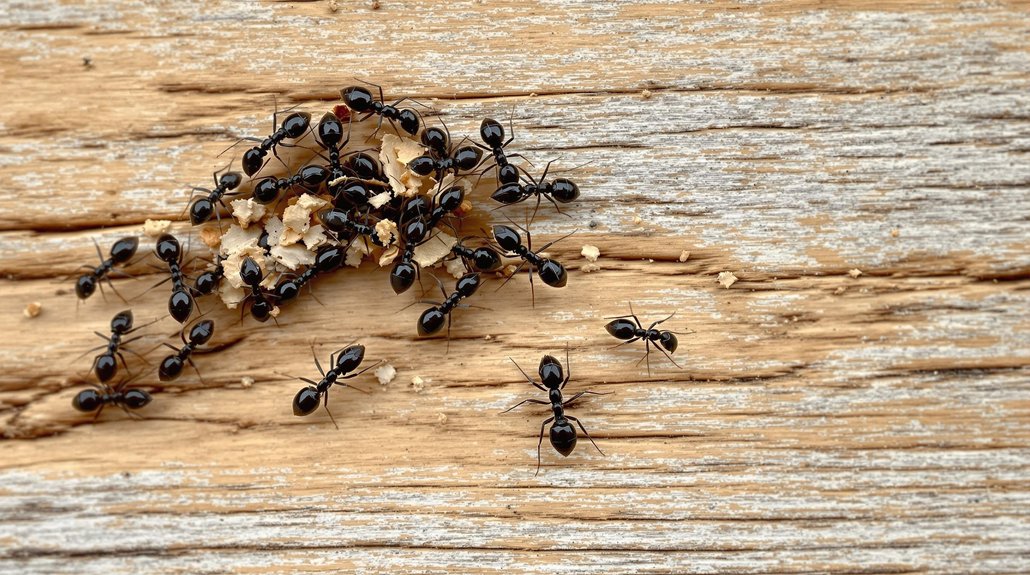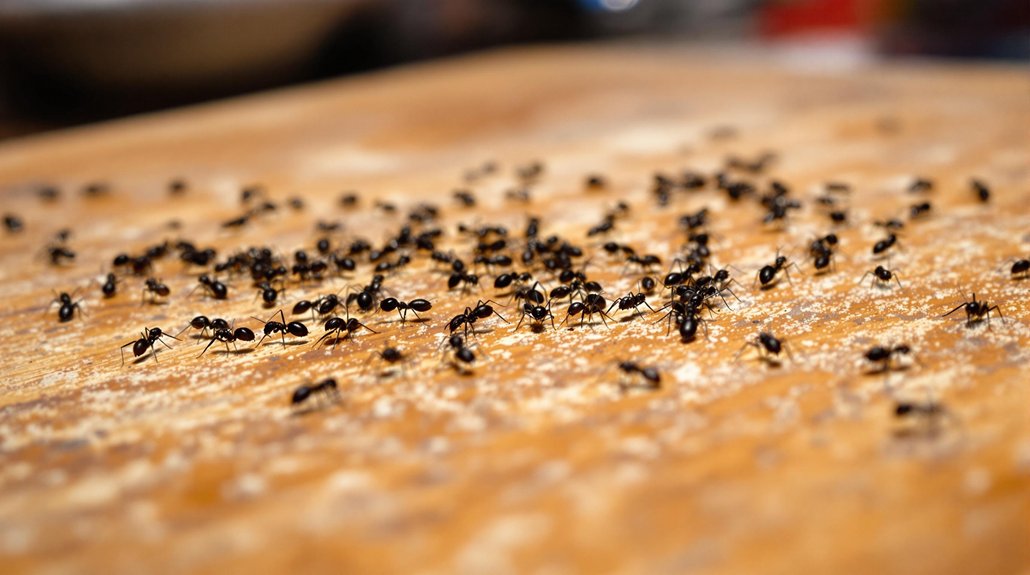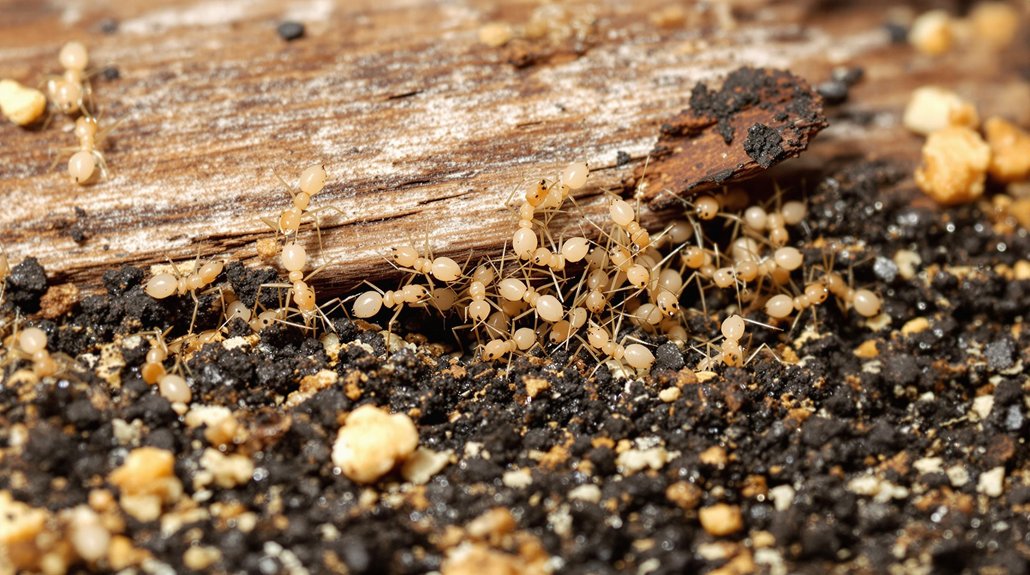Clayton, North Carolina, faces several common ant species that may become household pests. Carpenter ants can damage wood and form large colonies in moist areas. Odorous house ants emit a strong smell and often invade kitchens. Pavement ants nest beneath sidewalks and enter homes through cracks. Crazy ants move erratically, while little black ants are small, shiny, and seek water and food indoors. Thief ants steal food secretly. Acrobat and pyramid ants build unique nests. Learning more about these species can help with effective control.
Key Article Highlights
- Common ant species in Clayton include carpenter ants, odorous house ants, pavement ants, crazy ants, and little black ants.
- Carpenter ants damage wood and nest in moist or decayed structures, signaling potential structural issues.
- Odorous house ants emit a strong smell when crushed, often found foraging indoors for food and water.
- Pavement ants typically nest beneath pavement, soil, or mulch and invade homes through small cracks.
- Management relies on identifying species, locating nests, and using targeted treatments like baits and sealing entry points.
Carpenter Ants: The Wood Damagers

Carpenter ants are a common pest in Clayton, North Carolina, known for their ability to damage wood structures. These ants form large carpenter ant colonies, often nesting in moist or decayed wood. Their activity results in wood damage that can weaken the structural integrity of buildings. Carpenter ants do not eat wood but excavate it to create nests, leaving behind sawdust-like debris. Signs of infestation include rustling sounds within walls and the presence of worker ants. Early detection is essential to prevent extensive damage. Proper identification involves locating the nest and observing ant behavior. Managing carpenter ant problems requires removing moisture sources and eliminating decayed wood. Understanding their nesting habits helps homeowners take effective measures to control and prevent infestations.
Odorous House Ants: The Fragrant Intruders
Odorous house ants are known for their strong smell when crushed, which helps in their detection. Scientists use odor detection techniques to locate their colonies and assess the extent of infestations. Effective management involves identifying colony locations and implementing targeted control methods to reduce their presence.
Odor Detection Techniques
Detecting odorous house ants often relies on their distinctive scent trails, which can be identified by trained professionals. Odor detection methods involve analyzing chemical cues left by the ants as they move. These cues include pheromones and other chemical signals that guide colony members and reveal their presence. Skilled pest control experts use specialized tools, such as scent detection dogs or chemical analysis devices, to locate ant colonies based on these cues. Understanding the chemical composition of the scent trails helps in accurately identifying infestations. This approach allows for targeted treatment and control efforts. Mastery of odor detection techniques is essential for effective management of odorous house ants, enabling precise identification of colonies through their unique chemical cues and scent signatures.
Managing Fragrant Colonies
Managing fragrant colonies of odorous house ants requires a strategic approach to eliminate their presence effectively. Fragrant colony management involves targeting the source of the infestation and disrupting their trail. Scent trail removal is vital, as these ants rely heavily on their scent trails to navigate and communicate. Regular cleaning of affected areas with soapy water or vinegar helps erase these trails and reduces attraction. Sealing entry points prevents new colonies from establishing indoors. Baits designed for odorous house ants are effective in delivering poison directly to the colony, ensuring long-term control. Consistent monitoring and prompt action are essential to prevent resurgence. Proper fragrant colony management minimizes the chances of persistent infestations and restores control over the environment.
Pavement Ants: The Sidewalk Swarmers
Pavement ants are a common sight in urban and suburban areas of Clayton, North Carolina. Their behavior involves foraging along sidewalks and cracks, often entering homes through small gaps. These ants prefer habitats beneath pavement, soil, or mulch, where they establish large colonies. Their ability to adapt to various environments makes them resilient pests. Understanding pavement ant behavior and habitats is essential for effective control. They typically form trails, communicate through chemical signals, and tend to food sources diligently. Their presence can be identified by tiny, moving black ants on surfaces or near cracks. Managing these ants involves targeting their nesting sites and limiting access points. Below is a table illustrating their habitat preferences and behaviors:
| Habitat Type | Behavior Characteristics | Impact on Humans |
|---|---|---|
| Cracks in pavement | Trail formation, foraging | Entry points into structures |
| Soil beneath pavement | Colony expansion, nesting | Nuisance around foundations |
| Mulched areas | Food storage, shelter | Attraction to food spills |
Crazy Ants: The Erratic Foragers
While pavement ants tend to follow predictable trails and stay close to their nests, crazy ants exhibit more erratic foraging behavior. Their foraging patterns are irregular and unpredictable, making them difficult to track. Crazy ants move with erratic movements, often darting in different directions without a clear route. This behavior allows them to cover large areas quickly and locate food sources efficiently, despite their seemingly chaotic movements. Unlike other ant species that follow established paths, crazy ants explore randomly, which can lead to unexpected infestations inside structures. Their erratic foraging behavior helps them adapt to various environments and find resources swiftly. Recognizing these patterns is essential for effective pest management and controlling their spread in Clayton, North Carolina.
Little Black Ants: The Common Household Pests

Little black ants are common household pests in Clayton, North Carolina. They can be identified by their small size and shiny black appearance and often forage indoors for food and water. Effective prevention and control involve removing food sources, sealing entry points, and, if necessary, using targeted treatments.
Identification and Behavior
Little black ants are small, sleek insects commonly found inside homes in Clayton North Carolina. Their ant anatomy includes a shiny black exoskeleton, six legs, and antennae that help them sense their environment. These ants communicate primarily through chemical signals called pheromones, which guide others to food sources and nest sites. Their behavior involves forming trails along which they travel efficiently. Little black ants are highly adaptable and often establish colonies in hidden areas such as wall voids, beneath floors, or behind appliances. They forage for sweet foods and attract other ants through their scent trails. Understanding their ant communication methods and physical characteristics aids in recognizing and managing these pests effectively. Their simple yet efficient behavior contributes to their persistence indoors.
Prevention and Control
Preventing and controlling little black ants in homes requires a combination of sanitation, exclusion, and targeted treatments. Effective ant prevention strategies involve removing food sources, sealing entry points, and maintaining clean surfaces to reduce attractants. Pest control methods should focus on identifying ant trails and applying appropriate bait or residual insecticides directly where ants are active. Regular inspection and prompt response to signs of infestation are essential for long-term control. Exclusion techniques, such as sealing cracks and gaps, prevent new colonies from establishing. Proper sanitation minimizes food debris that encourages ant activity. Mastery of these pest control methods guarantees homeowners can manage little black ant problems efficiently, reducing reliance on Chemical Treatments and promoting a pest-free environment.
Thief Ants: The Stealthy Collectors

Thief ants are known for their ability to infiltrate homes and buildings quietly, often going unnoticed until a problem arises. Their habits include nesting in hidden locations such as wall voids, under appliances, and inside insulation. These ants are small, which helps them avoid detection and allows them to access food sources easily. Thief ant colonies are typically scattered, with multiple queens present, enabling rapid colony expansion. They are known to steal food from other ant colonies, earning their name as stealthy collectors. Their presence is often confirmed by identifying tiny ants near sweet or greasy food sources. Effective control requires understanding their habits and nesting sites, as well as targeted treatments to eliminate colonies without disturbing their secretive behavior.
Acrobat Ants: The Unique Nests
Acrobat ants are easily recognized by their distinctive nesting habits, which set them apart from other ant species. They create nests in various locations, often in tree hollows, behind panels, or inside wall voids. Their nest architecture is intricate, with chambers for brood and food storage. Colony dynamics involve multiple queens and large worker populations, allowing rapid expansion and resilience. These ants may also nest in decayed wood or under bark, depending on environmental conditions. Their adaptability to different nesting sites makes them successful across diverse habitats. Understanding their nest structure is essential for effective control. The table below summarizes key aspects of acrobat ant nests:
| Nest Location | Architecture Features | Colony Dynamics |
|---|---|---|
| Tree hollows | Multiple chambers, protected | Large colonies, multiple queens |
| Wall voids | Hidden, complex passageways | Rapid growth, high resilience |
| Decayed wood | Soft, easily accessible | Flexible colony size |
Pyramid Ants: The Mound Builders
Pyramid ants are known for their distinctive nesting behavior, often constructing large, mound-like structures in open areas. Their pyramid ant behavior involves building mounds composed of soil, which serve as their nests. These structures are typically found in yards, fields, or disturbed soil, making their habitat easily identifiable. Pyramid ant habitat preferences include sunny, well-drained locations where they can access food sources such as insects and plant material. Their mounds can vary in size but are usually prominent in the landscape. Understanding pyramid ant behavior and habitat helps in managing their presence. These ants are generally not aggressive but can become a nuisance when their mounds are disturbed or when they invade nearby structures. Proper identification is key to effective control.





